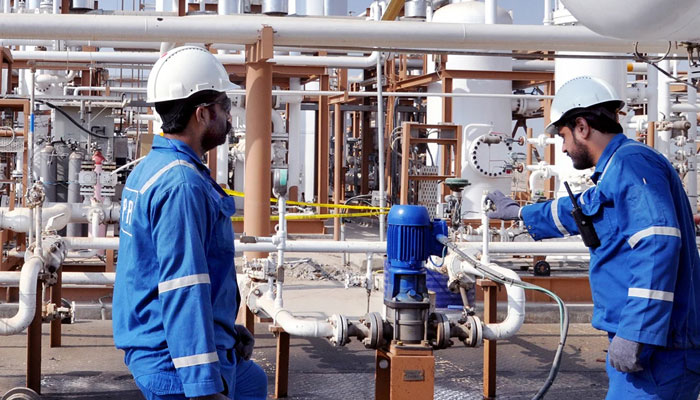PPL reports 26% YoY profit decline in 1HFY25
KARACHI: Pakistan Petroleum Limited (PPL) reported its financial results for the first half of fiscal year 2025 (1HFY25), posting a net profit of Rs50.91 billion (EPS: Rs18.71), marking a 26 per cent decline compared to the same period last year.
In the second quarter (2QFY25), earnings dropped by 30 per cent YoY to Rs27.34 billion (EPS: Rs10.05), mainly due to a significant tax reversal recorded in 2QFY24. The company also declared an interim cash dividend of Rs2 per share, bringing the total payout for 1HFY25 to Rs4 per share.
PPL’s net sales declined by 15 per cent YoY in 1HFY25 to Rs126.9 billion, primarily due to a 9.0 per cent and 5.0 per cent YoY reduction in oil and gas production, respectively, alongside a 12 per cent drop in oil prices, said a report of Arif Habib Ltd.
In 2QFY25, net sales fell 16 per cent YoY to Rs60.72 billion, impacted by a lower wellhead price for Sui gas, reduced oil production, rupee appreciation against the USD, and a 14 per cent decline in the Arab Light crude price.
Exploration costs decreased by 22 percent YoY to Rs6.7 billion in 1HFY25, with a 21 per cent YoY drop in 2QFY25 due to lower dry well costs. Meanwhile, other income surged by 97 per cent YoY to Rs15.24 billion in 1HFY25, with a notable 2x YoY jump in 2QFY25 to Rs8.85 billion, primarily driven by higher income from cash balances.
The company’s effective tax rate stood at 27 per cent in 2QFY25, compared to just 1.0 per cent in 2QFY24, when a reversal of depletion allowance was booked. Trade debts remained elevated at Rs576 billion as of December 2024, slightly up from Rs574 billion in September 2024. With a payout ratio of 21.4 per cent in 1HFY25, more than double the 9.9 per cent in the same period last year, PPL continues to focus on financial discipline while navigating production and pricing challenges.
-
 How King Charles Is Reacting To Abdication Rumours, Prince William's Succession Talks?
How King Charles Is Reacting To Abdication Rumours, Prince William's Succession Talks? -
 Space Race Intensifies As Russia Plans Lunar Nuclear Power Plant By 2036
Space Race Intensifies As Russia Plans Lunar Nuclear Power Plant By 2036 -
 Italy Orders Meta To Suspend WhatsApp Terms Prohibiting Rival AI Chatbots
Italy Orders Meta To Suspend WhatsApp Terms Prohibiting Rival AI Chatbots -
 Serena Williams Surprises Sister With Most Expensive Wedding Gift
Serena Williams Surprises Sister With Most Expensive Wedding Gift -
 Kris Jenner Names Kardashian-Jenner Who Is The ‘hardest’ To Get Gifts For
Kris Jenner Names Kardashian-Jenner Who Is The ‘hardest’ To Get Gifts For -
 Should Meghan Markle, Prince Harry Return To The UK For Christmas? Royal Fans Give Verdict
Should Meghan Markle, Prince Harry Return To The UK For Christmas? Royal Fans Give Verdict -
 Prince Harry, Meghan Markle Emotional Moment With Injured Dog Revealed
Prince Harry, Meghan Markle Emotional Moment With Injured Dog Revealed -
 Scientist Find New Clue To Spot Mental Health Risk
Scientist Find New Clue To Spot Mental Health Risk -
 UFO Expert Makes Startling Revelation About Interaction With Aliens
UFO Expert Makes Startling Revelation About Interaction With Aliens -
 Prince Harry 'determined' To Secure Stable Future For Archie, Lilibet Away From Crown
Prince Harry 'determined' To Secure Stable Future For Archie, Lilibet Away From Crown -
 Trump Flew On Epstein Jet Eight Times In 90s, Prosecutor Email Claims
Trump Flew On Epstein Jet Eight Times In 90s, Prosecutor Email Claims -
 Prince George Creates Style-stir Following Kate Middleton's 'effect'
Prince George Creates Style-stir Following Kate Middleton's 'effect' -
 Changing Cervical Cancer’s Future: Who Gets The HPV Vaccine?
Changing Cervical Cancer’s Future: Who Gets The HPV Vaccine? -
 King Charles’ Look For His Christmas Day Broadcast Released: ‘All Ruddy-cheeked And Smiling’
King Charles’ Look For His Christmas Day Broadcast Released: ‘All Ruddy-cheeked And Smiling’ -
 Ice Spice Sets Record Straight On Rumoured Beef With Latto
Ice Spice Sets Record Straight On Rumoured Beef With Latto -
 TikTok's ByteDance To Offer 50% Bonus For High Performers In 2026
TikTok's ByteDance To Offer 50% Bonus For High Performers In 2026




